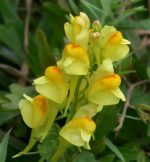 Also called butter-and-eggs, and wild snapdragon, this herbaceous perennial is a member of the plantain family, Plantaginaceae, that also includes snapdragon, foxglove, and turtlehead. It is native to Europe and Asia but was introduced into US in the late seventeenth century as an ornamental and medicinal plant and can now grow throughout most of the US. Growing from a long taproot with shallow rhizomes spreading in all directions, yellow toadflax reaches 1-2 tall and has an upright stem with few branches and many pale green leaves. The leaves are linear, up to 2. 5 inches long, hairless, sessile, and have smooth margins. The flowers appear in terminal spikes up to 9″ long beginning in early to mid-summer for about a month and are attracive to bees, butterflies and other insects. Each snapdragon-like flower is about 1″ long and has two large lips and a yellow spur that hangs down. The lips are pale yellow with a contrasting bright orange bearded throat. Seeds capsules contain many small brown flattened seeds surrounded by a papery wing with a notch on one side. Plant spread by seeds and rhizomes, and usually form colonies. Although valued for it medicinal properties, it is generally considered invasive and a noxious weed in the Southwest. Elsewhere, it can be an attractive addition to a meadow, praire, or cottage garden but extreme care should be taken to contain the plant’s spread. The genus name, Linaria, is from the Latin word linum meaning linen and refers to the similarity of the leaves to those of the flax plant. The specific epithet, vulgaris, is the Latin word meaning common.
Also called butter-and-eggs, and wild snapdragon, this herbaceous perennial is a member of the plantain family, Plantaginaceae, that also includes snapdragon, foxglove, and turtlehead. It is native to Europe and Asia but was introduced into US in the late seventeenth century as an ornamental and medicinal plant and can now grow throughout most of the US. Growing from a long taproot with shallow rhizomes spreading in all directions, yellow toadflax reaches 1-2 tall and has an upright stem with few branches and many pale green leaves. The leaves are linear, up to 2. 5 inches long, hairless, sessile, and have smooth margins. The flowers appear in terminal spikes up to 9″ long beginning in early to mid-summer for about a month and are attracive to bees, butterflies and other insects. Each snapdragon-like flower is about 1″ long and has two large lips and a yellow spur that hangs down. The lips are pale yellow with a contrasting bright orange bearded throat. Seeds capsules contain many small brown flattened seeds surrounded by a papery wing with a notch on one side. Plant spread by seeds and rhizomes, and usually form colonies. Although valued for it medicinal properties, it is generally considered invasive and a noxious weed in the Southwest. Elsewhere, it can be an attractive addition to a meadow, praire, or cottage garden but extreme care should be taken to contain the plant’s spread. The genus name, Linaria, is from the Latin word linum meaning linen and refers to the similarity of the leaves to those of the flax plant. The specific epithet, vulgaris, is the Latin word meaning common.
Type: Herbaceous perennial
Bloom: Terminal spikes of yellow snapdragon-like flowers from early to mid summer.
Size: 1-2′ H
Light: Full sun
Soil:Lean to average, dry to medium moist, well-drained
Hardiness: Zones 3-9
Care: Contain spread of the plant.
Pests and Diseases: Aphids, pwdery mildew
Propagation: Seed, division
Companion Plants: Butterfly weed (Asclepias tuberosa), Smooth Aster (Symphyotrichum laeve), Beeebalm (Monarda fistulosa)
Outstanding Selections: None
Photo Credit: Wikipedia